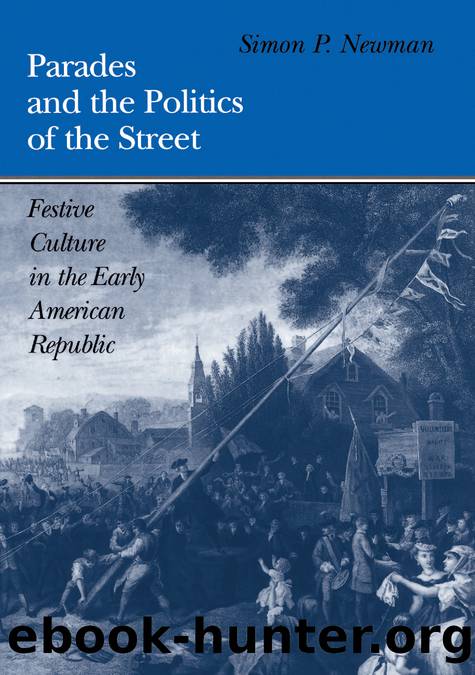Parades and the Politics of the Street by Newman Simon P.;

Author:Newman, Simon P.;
Language: eng
Format: epub
Publisher: University of Pennsylvania Press
Published: 2018-08-15T00:00:00+00:00
Throughout 1793, 1794, and 1795 the French Revolution provided partisans of the Democratic Republican party with some of their most effective weapons in the battle against the Federalists, and many ordinary folk gave both life and political power to these events, expressing their displeasure at Federalist policies and ideals that seemed rooted in counterrevolutionary ideology, and which were destined to hurt their material interests. While white Americans continued to invoke their own revolutionary heritage and the exceptionalism inherent to that invocation, this partisan adoption and employment of the French Revolutionâan event with far greater significance for the shaping of modern nations and democracies than the American war for independenceâsuggests that on this one point Americans who celebrated the French Revolution shared a more worldly viewpoint than was shared by those who condemned it.150
But from 1796 on, the increasing belligerence of the French Revolution and the rising tide of condemnation by American clergymen, together with the ensuing decline of Franco-American relations that continued until the turn of the century, combined to encourage Democratic Republican leaders to distance themselves from the French Revolution.151 As French armies conquered more and more of Europe, Jefferson and his allies began to recognize the threat that French power posed to American interests, and they distanced themselves from the French. Yet many ordinary Americans took far longer to move away from France, and celebrations of French victories continued until the end of the century. In Boston, for example, the sailors on board the ship Eagle celebrated Bastille Day in 1796 with âdistinguished conviviality.â152 The following spring âbetween two and three hundred citizens assembled at Kensingtonâ outside Philadelphia, in order to celebrate French victories in Italy. In a toast to âThe ship-carpenters of KensingtonâMay the next treaty made by our government give them bread instead of a stone,â these mechanics and artisans articulated their informed opposition to Federalist policies. Another toast to âThe patriots of 1776â and âthe spirit which animated them in that crisisâ says something of their radical ideology, as did one to the American Republic, which hoped that âthe glory of her revolution [may] never be tarnished by base ingratitude, or by a coalition with tyrants.â153 Cobbett dismissed these âship-carpentersâ as âseditious persons,â who thus had no legitimate place or role in national politics.154
Although these events were far more rare than the celebrations of the early to mid-1790s, they were kept alive by such ordinary folk as these and the pioneering yeoman farmers of Fayette County in Kentucky who celebrated French victories in Italy in 1800. This suggests that popular creation of and participation in French Revolutionary festive culture was by no means contingent on the enthusiasm of the Democratic Republican leadership. Ordinary citizens exercised more control than ever over the shape and content of these celebrations, expressing ideals that in some sense held Democratic Republican leaders to account: in one toast Kentucky citizens saluted Thomas McKean, the newly elected Democratic Republican governor of Pennsylvania, as an âold fashioned republican of 1776, who acknowledges no sovereign but the people.
Download
This site does not store any files on its server. We only index and link to content provided by other sites. Please contact the content providers to delete copyright contents if any and email us, we'll remove relevant links or contents immediately.
The Secret History by Donna Tartt(16664)
The Social Justice Warrior Handbook by Lisa De Pasquale(11494)
Thirteen Reasons Why by Jay Asher(7803)
This Is How You Lose Her by Junot Diaz(5800)
Weapons of Math Destruction by Cathy O'Neil(5048)
Zero to One by Peter Thiel(4836)
The Myth of the Strong Leader by Archie Brown(4796)
Promise Me, Dad by Joe Biden(4459)
Beartown by Fredrik Backman(4435)
Stone's Rules by Roger Stone(4423)
How Democracies Die by Steven Levitsky & Daniel Ziblatt(4415)
The Fire Next Time by James Baldwin(4352)
100 Deadly Skills by Clint Emerson(4086)
A Higher Loyalty: Truth, Lies, and Leadership by James Comey(4041)
Rise and Kill First by Ronen Bergman(4022)
The David Icke Guide to the Global Conspiracy (and how to end it) by David Icke(3892)
The Farm by Tom Rob Smith(3878)
Secrecy World by Jake Bernstein(3790)
The Doomsday Machine by Daniel Ellsberg(3738)
